 |
[ Outlaw Genealogy | Bruce
History | Lost Chords ] [ Projects | News | FAQ | Suggestions | Search | HotLinks | Resources | Ufo ] |
 |
[ Outlaw Genealogy | Bruce
History | Lost Chords ] [ Projects | News | FAQ | Suggestions | Search | HotLinks | Resources | Ufo ] |
The story of how/when/why Adam Outlawe came to be known as "Sir Adam or "Lord Adam" would add a great deal to our understanding of the Utlagh story. Twenty years before the reformation and thirty years before the beginning of the suppression. In 1472 he is referred only as a "chaplain" and continues in 1481, by 1501, near the time of his death he is referred to as "Sir Adam". So between 1481 and 1500 something happened.
He refers to "Thomas of Acre and Muriel his wife, were the founders of this chantry" and to benefactors, namely: Robert Malle and Agnes his wife.
The War of the Roses ends in 1485, The tudors take power King Henry VII. He formed an alliance with Holy Roman Emperor Maximilian I (1493–1519) and persuaded Pope Innocent VIII to issue a Bull of Excommunication against all pretenders to Henry's throne.
It maybe that Henry VII rise to power helped "Adam" become "Sir Adam", Later we see the rise of the Norfolk Boleyn/Howard families Thomas Howard, 2nd Duke of Norfolk .
1200-1250 - Deed
of grant, Lynn - 1d annual rent from a certain [piece of land] 4 feet
wide in Damgate held by Peter Strac
Grant by Laurence Outlaw (utlator) of Len to the
Hospital of the Blessed Mary Magdalen of Len and to the infirm brothers
there for the souls of his parents and his benefactors, the 1d to come from his
purse during his lifetime Anglo-Norman
Studies Proceedings of ... - Google Books -
There was an epidemic of leprosy in Europe from 1000 to 1200 A.D., which
was probably started by the returning soldiers of the Crusades. Leprosy
occurred in Britain from 625 to 1798, and at one time there were 326 lazar
houses (leprosaria) in Great Britain.
"Mary
Magdalene is a very strong connection with the Knights Templar. Whenever they
are about you’ll see St John the Baptist and Mary Magdalene."
1374 - Adam
OUTLAWE signed
ordinances of the Guild of St John the Baptist in West Lynn (ref.
BARDSLEY)
John de Ingaldesthorp, Knight - An essay towards a topographical history of the county of Norfolk
1481 - Feoffment
by Adam Outlawe of West Lynn, chaplain, to John
Dawson of Northlenn, chaplain, 1 September 1481 Thomas
de Acre's chantry and which were granted with other lands by William
Walton,
esquire, to Adam Outlawe and
John
Harold of North Lynn, shipmaster
1501 - Sir ADAM OUTLAWE, of West Lenn
(Lynn), St. Peters, priest, died 1501 - Bequeaths
a tenement to the West Lynn town bellman to pray for the souls of Thomas
of Acre and his wife Muriel -
Refers to Castle Acre in Kings Lynn - It is 15 miles (24 km) east
of the town of King's
Lynn Home
of Castle Acre Priory
1503 - Outlawe (Outelawe), Adam, Sir, priest, of Westlen, St Peter - Will
88 Lego portatori campanse orantis circa villam de Tykhull vjd. die
exequiarum pro anima mea (Test. Ebor., p. 141).
Sir Adam Outlaw, priest,
bequeaths a tenement to the West Lynn town bellman, on condition that on
the vigil of Sir Adam s "yere day" this bellman " pray
for the souls of Thomas of Acre and Muriel his wife, his (Sir Adam
s) soul, and the souls of his benefactors, with his bell going about
the town," &c. (Blomefield, Norfolk, viii. 536).
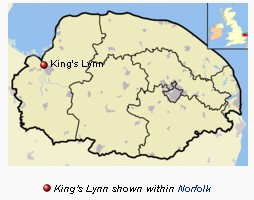 St
Peters, West Lynn - St. Peters Rd, West Lynn, King's Lynn, Norfolk PE34 3JF
St
Peters, West Lynn - St. Peters Rd, West Lynn, King's Lynn, Norfolk PE34 3JF
A small part, known as West Lynn, is on the west bank. Other districts of King's Lynn include the town centre, North Lynn, South Lynn, Gaywood, North Wootton, South Wootton, and Fairstead.
There is a splendid brass of a priest, Adam Outlaw (what a great name for the fens!) and the benches are a not unpleasing mix of 15th, 17th and 19th century work, most of a local quality. Perhaps best are some poppyheads reminiscent of those in the chancel at Walpole St Peter. The misericords are fascinating - they appear to have suffered the attention of iconoclasts, but also do not seem as old as they pretend.
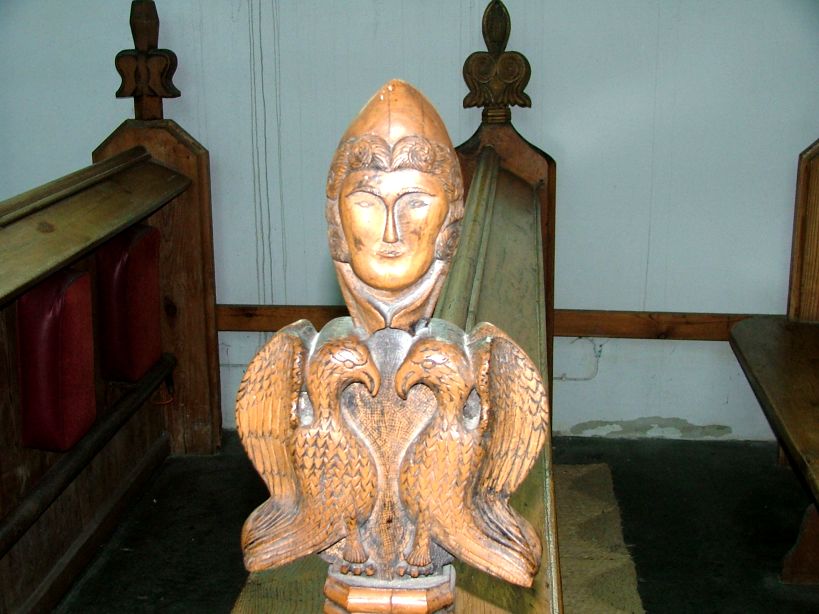 Sir ADAM OUTLAWE, of West Lenn (Lynn),
St. Peters, priest, died 1501, leaving a Will, by which he bequeathed
his chantry, lands and tenements thereto belonging, to Thomas Tyard, and after
his decease to remain to the Chantry of "Our Lady" in the Church at
St. Peters, the priest of it to pray for the good state of the aldermen,
brethren, etc., and for the souls of the same, namely: Thomas of Acre and
Muriel, his wife, and for the benefactors, namely: Robert Malle and Agnes his
wife, and for his (Outlaw's) own soul, the second Sunday of Lent. To the parish
clerk he gave three acres of land in North Lynn and to the bellman of the town
he gave the tenement called Bunchesham, at Cowgate, and an acre called
Vestyll's Acre, that he pray for the souls mentioned. Thomas of Acre and
Muriel his wife, were the founders of this chantry, and he died, as it seems,
patron of it, and left the patronage in the gift of the parishioners, the rector
or curate not to be feoffee of it. He served it as chantry priest. Sir Adam
Outlawe, priest, is buried in the church. (Blomefield's History of Norfolk).
- Trying to find information on his Benefactors : Robert Malle and Agnes his
wife
Sir ADAM OUTLAWE, of West Lenn (Lynn),
St. Peters, priest, died 1501, leaving a Will, by which he bequeathed
his chantry, lands and tenements thereto belonging, to Thomas Tyard, and after
his decease to remain to the Chantry of "Our Lady" in the Church at
St. Peters, the priest of it to pray for the good state of the aldermen,
brethren, etc., and for the souls of the same, namely: Thomas of Acre and
Muriel, his wife, and for the benefactors, namely: Robert Malle and Agnes his
wife, and for his (Outlaw's) own soul, the second Sunday of Lent. To the parish
clerk he gave three acres of land in North Lynn and to the bellman of the town
he gave the tenement called Bunchesham, at Cowgate, and an acre called
Vestyll's Acre, that he pray for the souls mentioned. Thomas of Acre and
Muriel his wife, were the founders of this chantry, and he died, as it seems,
patron of it, and left the patronage in the gift of the parishioners, the rector
or curate not to be feoffee of it. He served it as chantry priest. Sir Adam
Outlawe, priest, is buried in the church. (Blomefield's History of Norfolk).
- Trying to find information on his Benefactors : Robert Malle and Agnes his
wife
Robert Malle probably is Robert Maule or Mawle
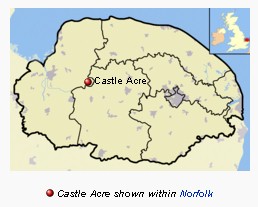
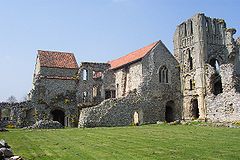 Thomas of Acre - Probably
refers to Castle
Acre in Kings Lynn - It is 15 miles (24 km) east of the town of -
King's
Lynn - Home
of Castle Acre Priory - but there is also West
Acre (barely a mile from Castle Acre) and South
Acre - South
Acre has many Templar associations - Harsick is probably the
stone effigy of a Knight Templar further west, Sir Eudo, who is known to
have taken part in the crusades
Thomas of Acre - Probably
refers to Castle
Acre in Kings Lynn - It is 15 miles (24 km) east of the town of -
King's
Lynn - Home
of Castle Acre Priory - but there is also West
Acre (barely a mile from Castle Acre) and South
Acre - South
Acre has many Templar associations - Harsick is probably the
stone effigy of a Knight Templar further west, Sir Eudo, who is known to
have taken part in the crusades
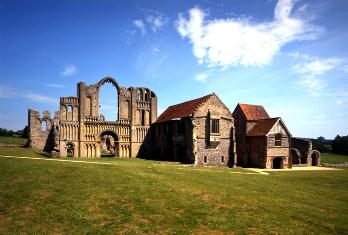 Castle Acre Priory
- Footsteps of Knight Templar - The Earl of Warenne, the founder of the great
Cluniac house, of Lewes, founded a priory of the same order at Castle Acre
between 1087 and 1089, making it subject to Lewes, as Lewes was subject to
Cluni. The founder endowed this priory of St. Mary with the Norfolk churches of
Castle Acre, Methwold,Wickmere, and Trunch, and the church of Leaden Roding,
Essex, together with two parts of the tithes of his demesnes in Grimston....On
22 November, 1537, Thomas Mailing and ten of the monks signed the
surrender of the priory and all its possessions.
Castle Acre Priory
- Footsteps of Knight Templar - The Earl of Warenne, the founder of the great
Cluniac house, of Lewes, founded a priory of the same order at Castle Acre
between 1087 and 1089, making it subject to Lewes, as Lewes was subject to
Cluni. The founder endowed this priory of St. Mary with the Norfolk churches of
Castle Acre, Methwold,Wickmere, and Trunch, and the church of Leaden Roding,
Essex, together with two parts of the tithes of his demesnes in Grimston....On
22 November, 1537, Thomas Mailing and ten of the monks signed the
surrender of the priory and all its possessions.
Castle Acre Priory Norfolk East of England - The estates eventually passed to Sir Edward Coke, whose descendant, the Earl of Leicester now owns the ruins and Castle Acre Castle.
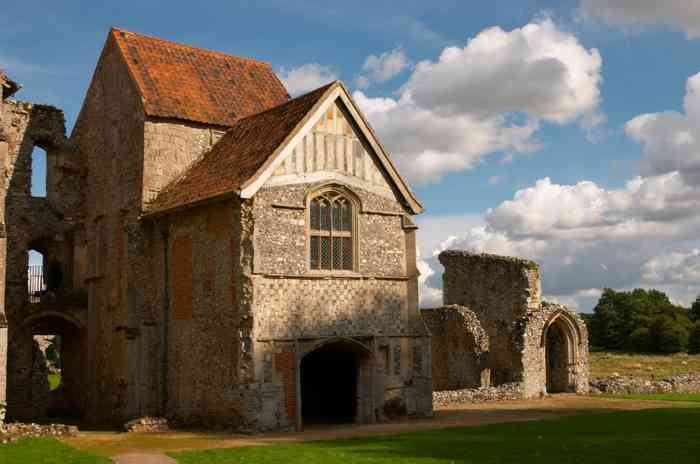
Another view of Castle Acre Priory
| - -- - -
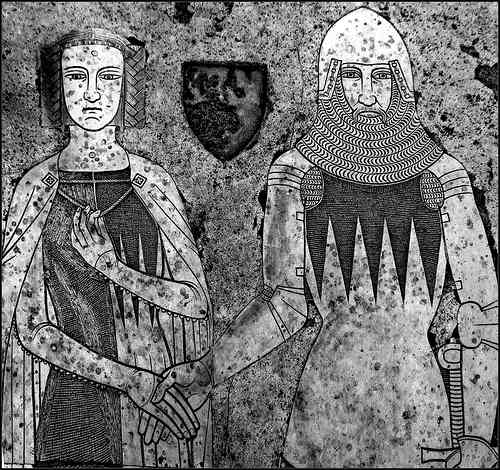 what will survive of us is love
- detail of the brass memorial to Sir John Harsyck and his wife
Katherine, 1384.
what will survive of us is love
- detail of the brass memorial to Sir John Harsyck and his wife
Katherine, 1384.
Nearby Castle
Acre is more famous, but the church of St
George at South Acre is both beautiful and interesting. The most famous
feature is the huge alabaster table monument to Sir Edward Barkham and his wife
88 Lego portatori campanse orantis circa villam de Tykhull vjd. die exequiarum pro anima mea (Test. Ebor., p. 141). Sir Adam Outlaw, priest, bequeaths a tenement to the West Lynn town bellman, on condition that on the vigil of Sir Adam s "yere day" this bellman " pray for the souls of Thomas of Acre and Muriel his wife, his (Sir Adam s) soul,, and the souls of his benefactors, with his bell going about the town," &c. (Blomefield, Norfolk, viii. 536).
http://www.holycross.edu/departments/visarts/projects/kempe/text/invest.html
The Book of Margery Kempe also offers such a record, in which places serve as memorial sites on which events from her past can spread and stretch and live out their stories. Events in the Book take place; they occur in a town called N, which we eventually discover to be Kempe's home town of Lynn, an important seaport on England's North Sea, or in Norwich, or in York or London; even more specifically, they occur within churches in these cities, so that the Book offers a detailed map of East Anglian and Yorkshsire parishes and cathedrals in the 15th century. Even within parishes, cathedrals, and priories, Kempe locates her memories according to place, often telling us with great precision where particular visions or conversations occur: she is within the Prior's Chapel, she is praying in the chancel at St. Stephen's Church in Norwich, she is in a chapel of St. James; she prays in St. Margaret's Church in a chapel of the Gesine.
Full text of History of the borough of King's Lynn
At the back, in Ferry Street, was the house in which the eccentric historian of the Fens, William Hall, alias "Antiquarian Hall, Will-Will-be-so, and Low-Fen Bill" (1748- 1815?) conducted his business.
It would be impossible to identify this building. In the north of the town was Boyland Hall, the baronial residence of Sir Richard de Boyland, a famous itinerant judge, who flourished about 1173. There was, moreover, a tenement called " Bunchesham," in the Cowgate, which belonged originally to Thomas de Acre, who, with his wife Muriel, founded a chantry at West Lenne. As he left the patronage in the hands of the parishioners, the priest Sir Adam Outlawe bequeathed it to "the bell town," of that place (1501). Besides, he demised to the parish clerk of Lenne three acres of land, minus the agrarian cow, "so that he do ring in pele on the vigil " of Sir Adam's year day. Possibly the priest was a descendant of Thomas Outlawe (the son of an outlaiv) who purchased the right of a little ferry boat for 13s. 4d. from the Gild of Corpus Christi (1399). No one would doubt the respectability of the priest, nor ought they that of John Outlawe, the son of Richard Outlawe, upon whom was conferred the freedom of our burgh (1456).
Full text of History of the borough of King's Lynn - Part II
The Trinity Gild acquired feiry rights (1392), and accounted for the income arising therefrom (1423). In 1399, Thomas Outlawe paid the gild-brethren of Corpus Christi, 13s. 4d. for the right of a little ferry-boat; and a descendant, it may be Sir Adam Outlawe — the priest at St. Peter's church, West Lenne, bequeathed two ferry rights to Thomas Tyard — ^one at the Cowgate (Common Staith), and the other at the Purfleet (1501).
A general history of the county of Norfolk: intended to convey all
... here is a brass of Adam Outlawe, 1503 . This person is called by Blomefield, Sir Adam Outlawe: but is presumed that 'Dominus' refers merely to his being a bachelor of arts. He is habited in the hood and gown of a master of arts in those days, except that he has not the maniple - his gown has an elegant border. This church is not the original of old lynn, which was destroyed by an inundation in 1271. The present church was erected soon after.